Plant Science Research Weekly: April 14, 2023
Review: Proximity labeling in plants
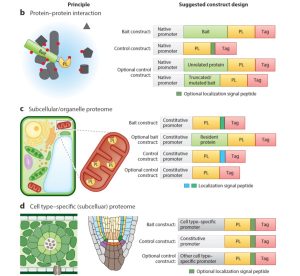 Genetic studies can suggest that two proteins function in the same pathway, but how can we figure out if they share the same space? In this review, Xu et al. provide an overview of proximity labeling, a method to identify proteins that co-localize in space. Proximity labeling uses a biotin ligase which is incubated with biotin to produce short-lived diffusible biotin adenylate intermediates. These tags are transferred to proteins within a very narrow (10nm) radius, and then the labeled proteins can be captured by streptavidin beads and identified through mass spectrometry; it’s a bit like throwing a tiny net into the cell and analyzing what is caught associating with what. The ligase can be fused to a protein of interest (bait) to search for its interactors, or targeted to an organelle, or expressed from a cell-specific promoter to query specific proteomes. These approaches have been enhanced by directed engineering of the biotin kinase enzyme to make it work faster, resulting in enzymes such as TurboID that can carry out proximity labeling in as little as ten minutes. This review focuses on the application of these methods in plants. (Summary by Mary Williams @PlantTeaching) Annu. Rev. Plant Biol. 10.1146/annurev-arplant-070522-052132
Genetic studies can suggest that two proteins function in the same pathway, but how can we figure out if they share the same space? In this review, Xu et al. provide an overview of proximity labeling, a method to identify proteins that co-localize in space. Proximity labeling uses a biotin ligase which is incubated with biotin to produce short-lived diffusible biotin adenylate intermediates. These tags are transferred to proteins within a very narrow (10nm) radius, and then the labeled proteins can be captured by streptavidin beads and identified through mass spectrometry; it’s a bit like throwing a tiny net into the cell and analyzing what is caught associating with what. The ligase can be fused to a protein of interest (bait) to search for its interactors, or targeted to an organelle, or expressed from a cell-specific promoter to query specific proteomes. These approaches have been enhanced by directed engineering of the biotin kinase enzyme to make it work faster, resulting in enzymes such as TurboID that can carry out proximity labeling in as little as ten minutes. This review focuses on the application of these methods in plants. (Summary by Mary Williams @PlantTeaching) Annu. Rev. Plant Biol. 10.1146/annurev-arplant-070522-052132
Review. Climate change impacts on seed production and quality: Current knowledge, implications, and mitigation strategies
 As the effects of climate change become increasingly severe and evident, there is growing concern about the future of food production. However, unlike its impact on crop yields, there is little clarity on the effects of climate change on the foundation of most agricultural systems: seed production and quality. In this paper, Maity and colleagues provide a detailed review of how climate change can affect the different phases of seed development and the seed supply chain. They focus on four abiotic factors: temperature, precipitation, CO2 concentration and UV radiation. An analysis with a selected crop pool indicates that some groups of plants’ seed yield and quality might be more susceptible to climate change, such as annuals, monocots and self-pollinated species. Still, the authors highlight the need for a more comprehensive quantitative analysis to assess the extent and magnitude of such impacts. Various strategies to potentially minimize the adverse effects of climate change are outlined, including seed enhancement technologies and directed breeding schemes. Given this, this review should be a primer for those interested in better understanding the effects of climate change on the seed industry and the alternative to deal with it. (Summary by Carlos A. Ordóñez-Parra @caordonezparra) Seed Sci. Technol. 10.15258/sst.2023.51.1.07
As the effects of climate change become increasingly severe and evident, there is growing concern about the future of food production. However, unlike its impact on crop yields, there is little clarity on the effects of climate change on the foundation of most agricultural systems: seed production and quality. In this paper, Maity and colleagues provide a detailed review of how climate change can affect the different phases of seed development and the seed supply chain. They focus on four abiotic factors: temperature, precipitation, CO2 concentration and UV radiation. An analysis with a selected crop pool indicates that some groups of plants’ seed yield and quality might be more susceptible to climate change, such as annuals, monocots and self-pollinated species. Still, the authors highlight the need for a more comprehensive quantitative analysis to assess the extent and magnitude of such impacts. Various strategies to potentially minimize the adverse effects of climate change are outlined, including seed enhancement technologies and directed breeding schemes. Given this, this review should be a primer for those interested in better understanding the effects of climate change on the seed industry and the alternative to deal with it. (Summary by Carlos A. Ordóñez-Parra @caordonezparra) Seed Sci. Technol. 10.15258/sst.2023.51.1.07
Long-distance turgor pressure changes induce local activation of plant glutamate receptor-like channels
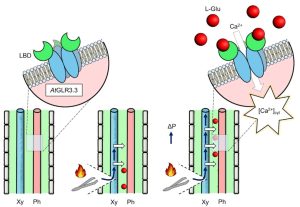 Following wounding or herbivory, plants can rapidly transmit signals systemically (over long distances). These systemic signals are thought to enhance plant defenses by preparing distant tissues for imminent attack. Genetic studies have shown that the glutamate receptor-like calcium channel GLR3.3 (a calcium-permeable channel activated by glutamate binding) is important for systemic signaling; opening this channel allows calcium to flow into cells, raising cytosolic calcium levels ([Ca2+]cyt) and initiating downstream signaling. Here, Grenzi et al. further explored how GLR3.3 acts in systemic signaling, first by demonstrating that the channel is in fact gated through the amino-acid binding site. Previous studies showed an increase in apoplastic L-Glu ([L-Glu]apo) occurs after wounding, which might cause the calcium channels to open. To test this, the authors developed an implantable bioelectronic device that allowed them to modulate [L-Glu]apo in the absence of liquid flow or wounding. They examined its effects in plants expressing fluorescent reporters for both [Ca2+]cyt and [L-Glu]apo. They found that a localized increase in L-Glu did not promote systemic propagating [Ca2+]cyt waves, whereas wounding does and is dependent on GLR3.3. However, systemic increases in [L-Glu]apo are independent of GLR3.3, suggesting that GLR3.3 acts downstream of [L-Glu]apo. How does wounding cause an increase in [L-Glu]apo? Interestingly, turgor pressure induced by wounding is sufficient to raise [L-Glu]apo. A model based on these findings suggests that wound-induced turgor pressure changes act as systemic signals and elevate [L-Glu]apo, which triggers localized [Ca2+]cyt changes via GLR3.3 in tissues removed from the wound site. (Summary by Mary Williams @PlantTeaching) Curr. Biol. 10.1016/j.cub.2023.01.042
Following wounding or herbivory, plants can rapidly transmit signals systemically (over long distances). These systemic signals are thought to enhance plant defenses by preparing distant tissues for imminent attack. Genetic studies have shown that the glutamate receptor-like calcium channel GLR3.3 (a calcium-permeable channel activated by glutamate binding) is important for systemic signaling; opening this channel allows calcium to flow into cells, raising cytosolic calcium levels ([Ca2+]cyt) and initiating downstream signaling. Here, Grenzi et al. further explored how GLR3.3 acts in systemic signaling, first by demonstrating that the channel is in fact gated through the amino-acid binding site. Previous studies showed an increase in apoplastic L-Glu ([L-Glu]apo) occurs after wounding, which might cause the calcium channels to open. To test this, the authors developed an implantable bioelectronic device that allowed them to modulate [L-Glu]apo in the absence of liquid flow or wounding. They examined its effects in plants expressing fluorescent reporters for both [Ca2+]cyt and [L-Glu]apo. They found that a localized increase in L-Glu did not promote systemic propagating [Ca2+]cyt waves, whereas wounding does and is dependent on GLR3.3. However, systemic increases in [L-Glu]apo are independent of GLR3.3, suggesting that GLR3.3 acts downstream of [L-Glu]apo. How does wounding cause an increase in [L-Glu]apo? Interestingly, turgor pressure induced by wounding is sufficient to raise [L-Glu]apo. A model based on these findings suggests that wound-induced turgor pressure changes act as systemic signals and elevate [L-Glu]apo, which triggers localized [Ca2+]cyt changes via GLR3.3 in tissues removed from the wound site. (Summary by Mary Williams @PlantTeaching) Curr. Biol. 10.1016/j.cub.2023.01.042
Fine tuning upstream open reading frames allow graded protein downregulation in plants
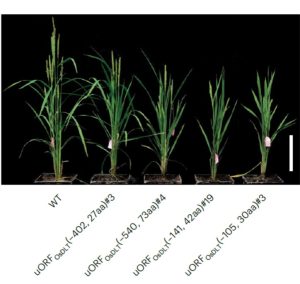 Regulatory components called upstream open reading frames (uORFs) are commonly found in eukaryotic mRNA molecules. These uORFs regulate the translation rate of downstream coding sequences. Xue et al. edited uORFs added or edited uORFs in several genes to investigate the effects of adding or extending uORFs. Using dual-luciferase assays, they showed that protein expression is significantly reduced when uORFs were extended in 5′ UTRs of different Arabidopsis and Oryza genes. With the same assay, they inserted de novo uORFs of different sizes (4-30 amino acid-long) into 5′ UTRs and graded their downregulation abilities. This allowed subtle changes via incremental inhibition of gene translation, and this was reflected in the phenotypic effects when endogenous genes were engineered. uORF editing to reduce protein translation could avoid adverse cellular consequences of gene knockouts. This paper is an exciting addition showing how precision genome editing can help crop breeding in the future. (Summary by Yen Peng (Apple) Chew @_applechew) Nature Biotechnol. 10.1038/s41587-023-01707-w
Regulatory components called upstream open reading frames (uORFs) are commonly found in eukaryotic mRNA molecules. These uORFs regulate the translation rate of downstream coding sequences. Xue et al. edited uORFs added or edited uORFs in several genes to investigate the effects of adding or extending uORFs. Using dual-luciferase assays, they showed that protein expression is significantly reduced when uORFs were extended in 5′ UTRs of different Arabidopsis and Oryza genes. With the same assay, they inserted de novo uORFs of different sizes (4-30 amino acid-long) into 5′ UTRs and graded their downregulation abilities. This allowed subtle changes via incremental inhibition of gene translation, and this was reflected in the phenotypic effects when endogenous genes were engineered. uORF editing to reduce protein translation could avoid adverse cellular consequences of gene knockouts. This paper is an exciting addition showing how precision genome editing can help crop breeding in the future. (Summary by Yen Peng (Apple) Chew @_applechew) Nature Biotechnol. 10.1038/s41587-023-01707-w
Uncovering the brassinosteroid gene regulatory networks in Arabidopsis root using single-cell RNA sequencing
 Brassinosteroid hormones regulate root growth and development by controlling cell division and elongation. However, it has been unclear why and how root cells with different identities and developmental stages respond to brassinosteroids differently. Nolan et al. used cutting-edge single-cell RNA sequencing (scRNA-seq) and tissue-specific gene manipulation methods to reveal that the root elongation cortex cells exhibit the most dramatic response to brassinosteroids. In this study, they conducted four sets of scRNA-seq experiments with various treatments and genotypes. Notably, they depleted the endogenous brassinosteroids with the brassinosteroid biosynthesis inhibitor Brassinazole (BRZ), and then reactivated the brassinosteroid signaling using Brassinolide (BL) in a time-series manner, using BRZ treatment as a control. (The datasets are accessible through an interactive browser: https://shiny.mdc-berlin.de/ARVEX/.) The scRNA-seq results revealed that cell wall-related genes, such as CELLULOSE SYNTHASES (CESAs) and CESA INTERACTIVE1 (CSI1), were induced at the elongating cortex by BL treatment, promoting the transition from cell division to elongation. By analyzing the trajectory of expression change, they identified two novel brassinosteroid responsive transcription factors, HAT7 and GTL1. Additionally, they created a tissue-specific knockout line of BRI1 in the root cortex to further investigate the important role of brassinosteroid in the elongating cortex. (Summary by Xiaohui Li @Xiao_hui_Li) Science, 10.1126/science.adf4721
Brassinosteroid hormones regulate root growth and development by controlling cell division and elongation. However, it has been unclear why and how root cells with different identities and developmental stages respond to brassinosteroids differently. Nolan et al. used cutting-edge single-cell RNA sequencing (scRNA-seq) and tissue-specific gene manipulation methods to reveal that the root elongation cortex cells exhibit the most dramatic response to brassinosteroids. In this study, they conducted four sets of scRNA-seq experiments with various treatments and genotypes. Notably, they depleted the endogenous brassinosteroids with the brassinosteroid biosynthesis inhibitor Brassinazole (BRZ), and then reactivated the brassinosteroid signaling using Brassinolide (BL) in a time-series manner, using BRZ treatment as a control. (The datasets are accessible through an interactive browser: https://shiny.mdc-berlin.de/ARVEX/.) The scRNA-seq results revealed that cell wall-related genes, such as CELLULOSE SYNTHASES (CESAs) and CESA INTERACTIVE1 (CSI1), were induced at the elongating cortex by BL treatment, promoting the transition from cell division to elongation. By analyzing the trajectory of expression change, they identified two novel brassinosteroid responsive transcription factors, HAT7 and GTL1. Additionally, they created a tissue-specific knockout line of BRI1 in the root cortex to further investigate the important role of brassinosteroid in the elongating cortex. (Summary by Xiaohui Li @Xiao_hui_Li) Science, 10.1126/science.adf4721
Gaining cis-elements contributed to enhanced expression of C4 genes
 C4 photosynthesis is derived from C3 photosynthesis. When related genes are compared, those involved in C4 photosynthesis tend to be more highly expressed. To understand this phenomenon, Singh et al. undertook a very impressive approach to look at transcriptional regulation of essentially all the photosynthetic genes in two members of the Brassicales, Arabidopsis thaliana (C3) and Cleome gynandra (C4). They focused on the first 24 hours of de-etiolation, when a dark-grown seeding is transferred to light and most of the photosynthetic genes are activated. They grouped the genes into expression clusters, and then further characterized them by looking at chromatin accessibility (DNase hypersensitivity), protein binding to the chromatin (Digital Genomic Footprinting), and the presence and occupancy of cis-regulatory elements. Although expression patterns of C3 and C4 genes were similar, the C4 genes showed enhanced expression levels. By undertaking such a comprehensive study, they were able to identify patterns that might not have been visible if only a small number of genes had been studied. There results highlight the accumulation of additional cis-regulatory elements, particularly G- and I-box elements, in the promoters of C4 genes as a key source of the elevated expression levels of these genes. (Summary by Mary Williams @PlantTeaching) Sci. Adv. 10.1126/sciadv.ade9756
C4 photosynthesis is derived from C3 photosynthesis. When related genes are compared, those involved in C4 photosynthesis tend to be more highly expressed. To understand this phenomenon, Singh et al. undertook a very impressive approach to look at transcriptional regulation of essentially all the photosynthetic genes in two members of the Brassicales, Arabidopsis thaliana (C3) and Cleome gynandra (C4). They focused on the first 24 hours of de-etiolation, when a dark-grown seeding is transferred to light and most of the photosynthetic genes are activated. They grouped the genes into expression clusters, and then further characterized them by looking at chromatin accessibility (DNase hypersensitivity), protein binding to the chromatin (Digital Genomic Footprinting), and the presence and occupancy of cis-regulatory elements. Although expression patterns of C3 and C4 genes were similar, the C4 genes showed enhanced expression levels. By undertaking such a comprehensive study, they were able to identify patterns that might not have been visible if only a small number of genes had been studied. There results highlight the accumulation of additional cis-regulatory elements, particularly G- and I-box elements, in the promoters of C4 genes as a key source of the elevated expression levels of these genes. (Summary by Mary Williams @PlantTeaching) Sci. Adv. 10.1126/sciadv.ade9756
Reduction of stomatal density by STOMAGEN paralog editing: a CRISPR/Cas9 way of having your cake and eating it too
 Climate change is having negative effects on yield of economically important crops such as rice. Therefore, there is a pressing need for climate-change adapted crops. Previous research has highlighted that a decrease in stomatal density can enhance drought tolerance. EPIDERMAL PATTERNING FACTOR-LIKE9 (EPFL9), also known as STOMAGEN, expressed in the mesophyll is a positive regulator of stomatal development. Knockout of STOMAGEN in rice using CRISPR/Cas9 resulted in lower stomatal density and greater water conservation, but also decreased carbon assimilation, which is essential for crop productivity. Therefore, Karavolias et al. devised a means of fine-tuning stomatal density while maintaining productivity in rice by editing EPFL10, a recently diverged close relative (paralog) of STOMAGEN. Stomatal density was decreased to only 25% of wildtype in the stomagen mutants, but to 80% of wildtype in the epf10 mutants. The epf10 mutants showed similar positive effects on water conservation as the stomagen mutants, but showed normal levels of carbon uptake and thermoregulation. These results show the potential of paralog editing for tuning stomatal density, which might be extended to other crops to improve their adaptability to abiotic stresses. (Summary by Idowu Arinola Obisesan, @IdowuAobisesan) Plant Physiol. 10.1093/plphys/kiad183
Climate change is having negative effects on yield of economically important crops such as rice. Therefore, there is a pressing need for climate-change adapted crops. Previous research has highlighted that a decrease in stomatal density can enhance drought tolerance. EPIDERMAL PATTERNING FACTOR-LIKE9 (EPFL9), also known as STOMAGEN, expressed in the mesophyll is a positive regulator of stomatal development. Knockout of STOMAGEN in rice using CRISPR/Cas9 resulted in lower stomatal density and greater water conservation, but also decreased carbon assimilation, which is essential for crop productivity. Therefore, Karavolias et al. devised a means of fine-tuning stomatal density while maintaining productivity in rice by editing EPFL10, a recently diverged close relative (paralog) of STOMAGEN. Stomatal density was decreased to only 25% of wildtype in the stomagen mutants, but to 80% of wildtype in the epf10 mutants. The epf10 mutants showed similar positive effects on water conservation as the stomagen mutants, but showed normal levels of carbon uptake and thermoregulation. These results show the potential of paralog editing for tuning stomatal density, which might be extended to other crops to improve their adaptability to abiotic stresses. (Summary by Idowu Arinola Obisesan, @IdowuAobisesan) Plant Physiol. 10.1093/plphys/kiad183
Hydraulic trade-offs underlie enhanced performance of polyploid trees under soil water deficit
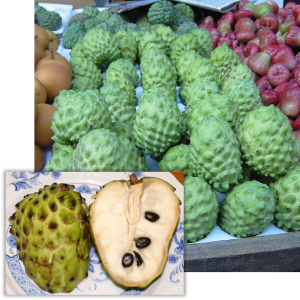 The (apparently delicious) fruit called atemoya is produced from a hybrid of Annona squamosa (sugar apple) × Annona cherimola (cherimoya), native to the American tropics but now grown widely. The hybridization event led to plants with several ploidies; diploid, triploid and tetraploid, which serve as the experimental material for a study by Losada et al. exploring the effect of ploidy on responses to water deficit in woody trees. Previous studies in herbaceous plants have shown that polyploids often show enhanced performance under stress, but few studies have been carried out in woody species. The authors studied seedlings and grafted scions of trees with the three types of ploidy under three irrigation regimes, examining functional anatomy and physiological parameters. They observed several differences between diploid, triploid, and tetraploid trees, but the key finding is that diploid trees are more efficient in conditions of water abundance, but more sensitive to water limitation, whereas polyploid trees showed a moderately more robust performance under drought. (Summary by Mary Williams @PlantTeaching) Plant Physiol. 10.1093/plphys/kiad204
The (apparently delicious) fruit called atemoya is produced from a hybrid of Annona squamosa (sugar apple) × Annona cherimola (cherimoya), native to the American tropics but now grown widely. The hybridization event led to plants with several ploidies; diploid, triploid and tetraploid, which serve as the experimental material for a study by Losada et al. exploring the effect of ploidy on responses to water deficit in woody trees. Previous studies in herbaceous plants have shown that polyploids often show enhanced performance under stress, but few studies have been carried out in woody species. The authors studied seedlings and grafted scions of trees with the three types of ploidy under three irrigation regimes, examining functional anatomy and physiological parameters. They observed several differences between diploid, triploid, and tetraploid trees, but the key finding is that diploid trees are more efficient in conditions of water abundance, but more sensitive to water limitation, whereas polyploid trees showed a moderately more robust performance under drought. (Summary by Mary Williams @PlantTeaching) Plant Physiol. 10.1093/plphys/kiad204
How did the daisy get its spots? Gene co-option and fly mimicry
 This is one of those “straight into the textbook” stories. Kellenberger et al. investigated the unusual petal pigmentation pattern of a South African daisy Gorteria diffusa, which has petals with odd lumpy irregular spots that mimic female flies and enhance pollination through sexual deception. The authors undertook an analysis of genes expressed in the spotted parts of the petal versus non-spotted parts, as well as related varieties, to identify the molecular origins of these fly-like spots. Their findings indicate that three groups of genes with other functions in the plant have been co-opted to form these new spots. One group of genes is responsible for the dark pigmentation, and includes genes involved in anthocyanin biosynthesis as well as genes involved in iron homeostasis; binding of iron by anthocyanins darkens the pigments. Another upregulated gene is responsible for the lumpy, possibly fly-like texture and encodes an expansin, a cell-wall loosening protein that is normally expressed in root hairs. The final gene module (SPL1 and a complementary miRNA) controls which petals the spots appear on through shifts in developmental timing. These daisies have several morphotypes which vary in their fly-likeness, providing additional insights into this evolutionary process, which appears to have occured in a modular fashion and rapidly. (Summary by Mary Williams @PlantTeaching) Curr. Biol. 10.1016/j.cub.2023.03.003
This is one of those “straight into the textbook” stories. Kellenberger et al. investigated the unusual petal pigmentation pattern of a South African daisy Gorteria diffusa, which has petals with odd lumpy irregular spots that mimic female flies and enhance pollination through sexual deception. The authors undertook an analysis of genes expressed in the spotted parts of the petal versus non-spotted parts, as well as related varieties, to identify the molecular origins of these fly-like spots. Their findings indicate that three groups of genes with other functions in the plant have been co-opted to form these new spots. One group of genes is responsible for the dark pigmentation, and includes genes involved in anthocyanin biosynthesis as well as genes involved in iron homeostasis; binding of iron by anthocyanins darkens the pigments. Another upregulated gene is responsible for the lumpy, possibly fly-like texture and encodes an expansin, a cell-wall loosening protein that is normally expressed in root hairs. The final gene module (SPL1 and a complementary miRNA) controls which petals the spots appear on through shifts in developmental timing. These daisies have several morphotypes which vary in their fly-likeness, providing additional insights into this evolutionary process, which appears to have occured in a modular fashion and rapidly. (Summary by Mary Williams @PlantTeaching) Curr. Biol. 10.1016/j.cub.2023.03.003
Plants cultivated for ecosystem restoration can evolve towards a domestication syndrome
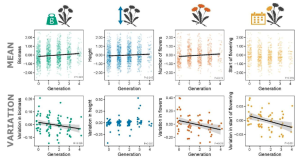 The pressing need to restore degraded areas has led to an unprecedented demand for native seeds. However, seeds are not always available in sufficient quantity and quality in nature, so some restoration practitioners might opt to source their seeds from wild plants grown on farms, just like any crop. While this practice has great potential to meet restoration project demands, there is an ongoing debate on whether seeds from plants under cultivation truly resemble the characteristics of those collected in the wild. In this research, Conrady and colleagues compared the traits of 19 species from European mesic grasslands grown from seeds that have undergone up to four cultivation generations with those from wild populations. The authors show that features such as plant height, biomass, and flower number increased through cultivation generations. Moreover, plant populations became more homogeneous with every cultivation generation. While this effect was species-specific, this study provides evidence that cultivation leads to trait changes that could affect the performance of individual plants and the resilience of restored areas. Therefore, this research provides a solid baseline for guidelines about using seeds from cultivated materials. (Summary by Carlos A. Ordóñez-Parra @caordonezparra) bioRxiv 10.1101/2023.02.27.530164
The pressing need to restore degraded areas has led to an unprecedented demand for native seeds. However, seeds are not always available in sufficient quantity and quality in nature, so some restoration practitioners might opt to source their seeds from wild plants grown on farms, just like any crop. While this practice has great potential to meet restoration project demands, there is an ongoing debate on whether seeds from plants under cultivation truly resemble the characteristics of those collected in the wild. In this research, Conrady and colleagues compared the traits of 19 species from European mesic grasslands grown from seeds that have undergone up to four cultivation generations with those from wild populations. The authors show that features such as plant height, biomass, and flower number increased through cultivation generations. Moreover, plant populations became more homogeneous with every cultivation generation. While this effect was species-specific, this study provides evidence that cultivation leads to trait changes that could affect the performance of individual plants and the resilience of restored areas. Therefore, this research provides a solid baseline for guidelines about using seeds from cultivated materials. (Summary by Carlos A. Ordóñez-Parra @caordonezparra) bioRxiv 10.1101/2023.02.27.530164



